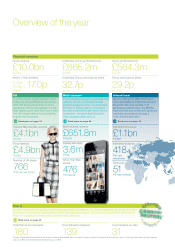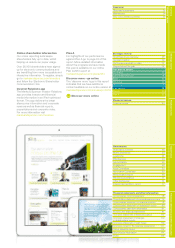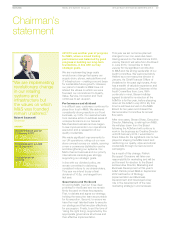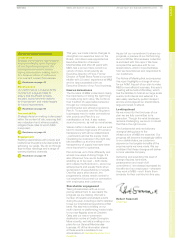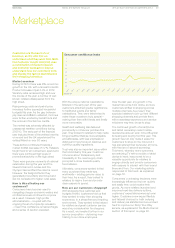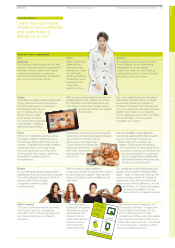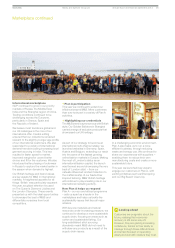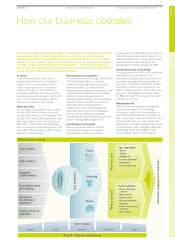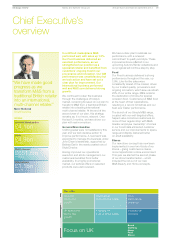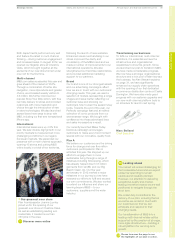Marks and Spencer 2013 Annual Report Download - page 6
Download and view the complete annual report
Please find page 6 of the 2013 Marks and Spencer annual report below. You can navigate through the pages in the report by either clicking on the pages listed below, or by using the keyword search tool below to find specific information within the annual report.
Overview Marks and Spencer Group plc Annual report and financial statements 2013 04
Customers are the heart of our
business, so it is vital that we
understand what they want from M&S.
Our Customer Insight Unit (CIU) uses
a combination of market research
and customer feedback to help us
understand how our customers think
and identify the factors that influence
their shopping behaviour.
Market overview
During 2012/13 there was little economic
growth in the UK, with a Gross Domestic
Product increase of just 0.3% in 2012.
Vacancy rates remained high and over
the course of the year a number of well
known retailers disappeared from the
high street.
Rising energy costs and petrol price
increases further squeezed household
budgets this year. As the gap between
pay rises and inflation widened, incomes
were further eroded by benefit cuts and
the removal of certain tax credits.
The market was adversely affected by
unseasonal weather conditions during
2012/13. The early part of the financial
year included three of the wettest months
on record and the UK experienced the
coldest March in over 50 years.
These factors contributed towards a
market footfall decrease of 3.7%. Retailers
fought hard to win consumers’ spend and
there were continued high levels of
promotional activity on the high street.
There were genuine moments of national
celebration during the year and The
Queen’s Diamond Jubilee and the
Olympic Games lifted the nation’s mood.
However, the feelgood factor they
generated proved fairly short-lived and
did not translate into higher retail sales.
How is this affecting our
customers?
Consumers have become used to
navigating choppy economic waters and
confidence levels continued to improve
as a result. However, high profile
administrations – coupled with the
ongoing threat of a triple dip recession
– meant this confidence remained fragile
and a sense of caution prevailed.
With the unique national celebrations
finished in the early part of the year,
customers attached greater significance
to traditional events and family
celebrations. They were determined to
make these occasions truly special –
making their time with friends and family
more memorable.
Health and wellbeing also featured
prominently in consumer priorities this
year. They looked to retailers to help make
living a healthier lifestyle more enjoyable
and affordable, with less emphasis on
dieting and more focus on delicious and
nutritious quality ingredients.
Trust was also an important issue within
the food industry this year. Customer
concerns about transparency and
traceability in the meat supply chain
prompted a move towards quality
food retailers.
Ultimately, consumers wanted to feel
every purchase they made was
worthwhile – adding genuine value to
their lives. As a result, they looked to
retailers to inspire them and provide
clear reasons to spend.
How are our customers shopping?
With shopping trips restricted and
budgets limited, customers told us that
they wanted to enjoy their shopping
experience, in a stress-free and inspiring
environment. They wanted to feel valued
by retailers and great customer service
was a key consideration for shoppers.
As a result, we invested further in our
service proposition – delivering new
training to our store employees.
Over the last year, any growth in the
market has come from online, as more
customers shifted to shopping across
multiple channels. As a result, they
expected retailers to join up their different
shopping channels and provide them
with a seamless experience and service
whichever way they chose to shop.
The continued growth of smartphone
and tablet ownership meant mobile
devices became an even more influential
browsing and buying tool this year. This
growth has not only made it easier for
customers to shop on the move but it
has also altered their behaviour at home,
with the rise of ‘second screening’.
This trend, whereby more customers
are watching TV with a mobile or tablet
device in hand, has proved to be a
valuable opportunity for retailers to
engage directly and provide consumers
with reasons to interact with their brand
there and then. Our marketing activity
responded to this trend, as explained
on page 16.
Consumers’ purchasing decisions were
increasingly influenced by how quickly
and easily they could receive their
goods. As more retailers launched and
improved next day delivery options,
customers’ expectations were set even
higher. Customers now expect flexible
and tailored choices for both ordering
and delivery as standard and we worked
hard to improve our Shop Your Way
service, as explained in the Multi-channel
section of this report on page 26.
Marketplace
Consumer confidence index
-40
Source GfK
-35
-30
-25
-20
-15
-10
0
-5
Nov 11
Dec 11
Jan 12
Feb 12
Mar 12
Apr 12
May 12
Jun 12
Jul 12
Aug 12
Sep 12
Oct 12
Nov 12
Dec 12
Jan 13
Feb 13
Mar 13
Apr 13


